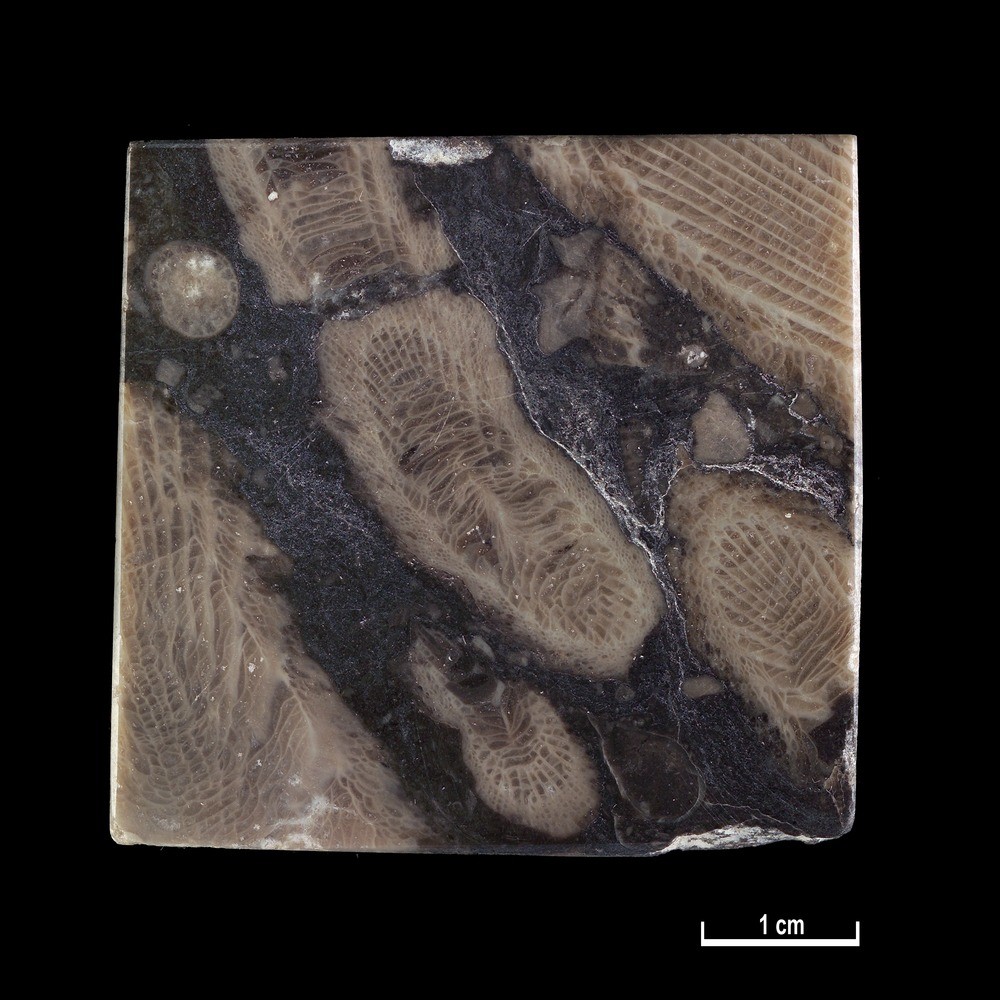| P number: | P576208 |
|---|---|
| Caption: | Marble specimen. Frosterley, Durham. Harehope Quarries, near Frosterley, Durham. |
| Description: |
Label name: Frosterley, Durham. Specimen description: Dark grey-black with large grey-fawn fossils. Text from: Watson, J. British and foreign marbles and other ornamental stones. Cambridge : University Press, 1916. 39 FROSTERLEY. Harehope Quarries, near Frosterley, Co. Durham. This specimen represents a highly fossiliferous limerstone, which is found near Frosterley, a village on the left bank of the river Wear, in the county of Durham. The bed is usually about two feet in thickness, and forms a part of the Great Limestone, which occurs towards the top of the Carboniferous Limestone series. Large sound blocks can often be obtained suitable for panels or monolithic columns. As the specimen skews, it is rich in fossil corals, of which Dibunophyllum, Diphyphyllum, and Lithostrotion, are the most numerous. When polished these fossils skew to advantage in contrast with the dark greyish brown ground-mass of the rock. Frosterley has the reputation of being one of the earliest known varieties of marble used for ecclesiastical decorative work in the British Isles, especially in the North of England, where its employment was contemporaneous with that of Purbeck Marble in the South of England Some authorities assert that the northerly rock is. better calculated to withstand the decaying influences of the atmosphere than is the Purbeck of the south. Instances of the use of Frosterley Marble for decorative work date back to an early period. The columns of the Nine Altars Chapel in Durham Cathedral (thirteenth century), and part of the pavement of York Minster (fourteenth century) are composed of it. Later it ceased to be used, and for a long period the beds of Frosterley Marble were neglected and practically unknown. Now, however, the band has been rediscovered and a regular supply can be obtained. The steps leading from the choir to the chancel-of Peterborough Cathedral were made of it in 1903, and the base and portions of the superstructure of the monument, erected in 1905, to the memory of Dean Ingram, irk the same cathedral, are made of this marble. It may also be seen in the pavement of the chancel of Bristol Cathedral (1895), in the clustered pillars in the Roman Catholic Church of Norwich (1885), and in the base of the marble pulpit in the Cathedral at Bombay. The base of the super-altar, erected in 1881, in St Andrew's Church, Cherryhinton, a village near Cambridge; is a good local example. Frosterley Marble is sometimes known as Stanhope Black Marble, named after Stanhope, a market-town about two miles west of the village of Frosterley. |
| Date taken: | Thu Jan 01 00:00:00 GMT 2004 |
| Photographer: | McIntyre, B.M. |
| Copyright statement: | NERC |
| Additional information: | The marble is from the Walter Brown Collection, Scottish Mineral and Lapidary Club. |
| Orientation: | Square |
| Size: | 233.55 KB; 1000 x 1000 pixels; 85 x 85 mm (print at 300 DPI); 265 x 265 mm (screen at 96 DPI); |
| Average Rating: | Not yet rated |
| Categories: | Best of BGS Images/ Stone and the built heritage (Building Britain) |
Reviews
There is currently no feedback

